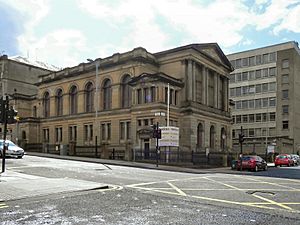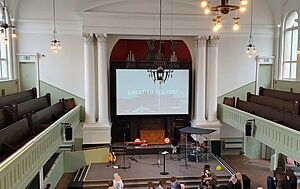Adelaide Place Baptist Church facts for kids
Quick facts for kids Adelaide Place Baptist Church |
|
|---|---|

Adelaide Place Baptist Church
|
|
| Location | Glasgow |
| Country | Scotland |
| Denomination | Baptist |
| History | |
| Founded | 1829 |
| Architecture | |
| Functional status | In use |
Adelaide Place Baptist Church is a historic Baptist church located in the Charing Cross area of Glasgow, Scotland. The church got its name from Adelaide Place, which was the old name for that part of Bath Street.
Founded way back in 1829, the church has a long history of helping the community. The beautiful building you see today was finished in 1877. For many years, it was a very important center for Baptist churches in Scotland and started many projects to help people in need. It is part of the Baptist Union of Scotland.
Contents
History of the Church
The church began in 1829 with Reverend James Paterson. At first, the congregation met in a rented room. As more people joined, they had to move to bigger places. In 1835, they built their own church on Hope Street. Today, that spot is part of Glasgow Central Station!
By the 1870s, they needed an even bigger building. So, they built the current church on Adelaide Place, which is now part of Bath Street. The congregation moved into their new home in 1876.
Helping People Learn
Long before Scotland had a public school system for everyone, the church offered evening classes to teach basic reading and writing.
Dr. Paterson, the first pastor, also helped start the Glasgow Commercial College in 1846. This college gave young business people a university-level education. It later became part of what is now the University of Strathclyde.
The church also housed the Baptist Theological College from 1894 to 1925. This college trained people to become church leaders.
A Center for Scottish Baptists
In 1870, a group of 51 churches came together to form the Baptist Union of Scotland. This important meeting happened in the church's old building on Hope Street. Because of its central role, a newspaper once called the church "the Cathedral Church of the Baptists in the West of Scotland."
Through Times of War
The church and its members lived through both World Wars. A special communion table in the church is dedicated to the memory of the men from the congregation who died in the First and Second World Wars.
During the wars, women from the church sewed packages of "comforts" to send to soldiers. One member, Marjorie McInnes, even served as a fire-watcher on the church roof during air raids to keep the building safe. The church also opened its doors every day for anyone who wanted a quiet place to pray.
Changes After the War
After World War II, many people moved from the city center to new suburbs. This meant the church had a smaller congregation, which made it hard to pay for the large building. They thought about moving but decided to stay.
In 1974, Reverend Donald McCallum was inspired to help homeless young women. He and some volunteers opened a home to care for them. This project grew into a charity called the Elpis Centre, named after the Greek word for 'hope'. The Elpis Centre still provides housing and support for young women today.
Big Repairs and New Ideas
In the 1990s, the church building had a serious problem called dry rot. The repairs were going to be very expensive. Instead of giving up, the congregation came up with a clever plan.
They started businesses inside the church building to help pay for the repairs and support the church's work. They turned part of the building into a guest house and the basement into a nursery. This allowed them to fix the building and keep serving the community.
The Light of Renewal Project
From 2017 to 2023, the church went through another major renovation. The outside stonework was repaired, and the main hall was updated. They added a community cafe space, improved access for people with disabilities, and put in new windows. The guest house was changed back into offices and meeting rooms for the church.
The Church Building
The Adelaide Place Baptist Church was built from 1875 to 1877. It was designed by the architect Thomas Lennox Watson. The building has a grand, classical style and is made from a beautiful, light-colored stone.
The main entrance on Pitt Street has a wide stone staircase leading up to large doors. Inside, the main hall, called the auditorium, has a balcony on three sides. At the front is a platform where the services are held. Behind the platform, you can still see the pipes of the old pipe organ.
The church is famous for its three beautiful stained-glass windows. They were made by W. and J. J. Kerr and show scenes from the Bible. Because of its historical and architectural importance, the building is a Category B listed building, which means it is officially protected.
Church Leaders Over the Years
The church has been led by many pastors since it was founded in 1829. Here is a list of the main pastors who have served the congregation.
| Name | Term of Service |
|---|---|
| James Paterson | 1829–1880 |
| Samuel Chapman | 1870–1877 |
| James Culross | 1878–1883 |
| D. P. MacPherson | 1883–1887 |
| T. H. Martin | 1888–1918 |
| T. N. Tattersall | 1921–1924 |
| J. E. Roberts | 1925–1929 |
| R. W. Waddelow | 1931–1947 |
| F. G. Hastings | 1948–1952 |
| George Armstrong Young | 1952–1968 |
| Donald P. McCallum | 1970–1982 |
| John (Jack) Quinn | 1984–2013 |
| Stephen Crothers | 2012– present |
Associate pastors
| Name | Term of Service |
|---|---|
| Paul Gardiner | 1975–1978 |
| Ronnie Hall | 2007–2011 |
Famous Church Members
Over its long history, the church has had many members who did amazing things.
- William Quarrier (1829–1903): A kind man who founded the Orphan Homes of Scotland to care for children in need. This later became the charity known as Quarriers.
- Joseph Coats (1848–1899): A doctor and professor who was also a leader in the church. He was the first president of the Baptist Theological College.
- Marjorie McInnes (1917–2015): The only woman ever to be president of the Baptist Union of Scotland. She helped make social work a profession in Scotland.
Daughter Churches
As the church grew, some members left to start new Baptist churches in other parts of Glasgow. These are sometimes called "daughter churches."
- Queens Park Baptist Church was started in 1878 by four members from Adelaide Place.
- Hillhead Baptist Church was formed in 1883 by a group from Adelaide Place who lived in the Hillhead area.
- Bearsden Baptist Church was started in 1973 by members from both Hillhead and Adelaide Place churches.
These churches helped spread the Baptist community across Glasgow, and most are still active today.
The Church Today
Today, Adelaide Place Baptist Church is an active and welcoming community. It has a few staff members, but most of the church's work is done by teams of volunteers. The church is also a registered Scottish charity, continuing its long tradition of helping others.



